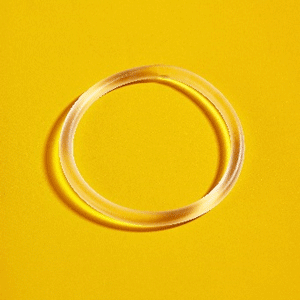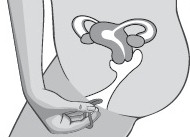What is the vaginal contraceptive ring?
- The vaginal contraceptive ring is a soft, 5.5 cm (2 in.), clear, plastic (non-latex) ring that you put in your vagina to prevent pregnancy.
- The ring contains hormones (estrogen and progestin) that are like a woman’s natural hormones. They stop the ovaries from releasing an egg. You can’t get pregnant if you don’t release an egg.
How well does the ring work?
- There’s about an
85% chance of getting pregnant after 1 year of having unprotected sex.
- With typical use (not following the exact directions) the ring is
91% effective.
- With perfect use (you follow the exact directions all the time) the ring is
99.7% effective.
- Most pregnancies happen because women don’t use the ring as directed.
- The ring doesn’t protect you from sexually transmitted infections (STIs) or HIV.
- Use a condom every time you have sex (vaginal, oral, anal) to lower your risk of STIs and HIV.
How do I start using the ring?
You need a prescription from your health care provider. There are different ways to start the ring. If you start on:
- day 1 of your period, it works right away to prevent pregnancy
- any other day, use a backup form of birth control (e.g., condoms, abstinence) for 7 days
How do I use the ring?
Put the ring in your vagina. Leave the ring in for
3 weeks (21 days). After 3 weeks, take the ring out. You’ll start your 7 hormone-free days. You’ll get your period when you aren’t wearing the ring. You’re still protected from pregnancy during this time.
After your 7 hormone-free days, always put in a
new ring. Even if you still have your period, you need to put a new ring in. You can use a tampon when you have the ring in. If you haven’t had your period, put a new ring in and contact your health care provider.
How do I put the ring in?

- Wash your hands. Get into a comfortable position (e.g., standing with one foot up on a chair).
- Squeeze the ring between your thumb and finger. Gently push it up into your vagina. It doesn’t matter how the ring is placed, as long as it’s high enough that it won’t fall out. If it feels uncomfortable, the ring might not be up far enough. Use your finger to push it further up. The ring can’t get lost in your vagina or be pushed in too far.
How do I take the ring out?
- Wash your hands.
- Hook your finger under the rim and pull the ring down and out. Throw it in the garbage, away from children and pets because it still contains hormones.
What are the benefits of the ring?
- Your period may be more regular, lighter, and/or shorter with less cramping.
- The ring may lower your risk of ovarian and endometrial cancer.
- The ring may help with acne and painful periods (dysmenorrhea).
- It’s safe to use the ring for many years. There’s no need to “take a break” from the ring.
- You can get pregnant as soon as you stop using the ring.
What are the side effects of the ring?
There’s a chance (more likely in the first 3 months) that you might have:
- headaches
- tender breasts
- bloating
- upset stomach (nausea)
- moodiness
- slight weight gain or loss
- spotting or bleeding between periods
- vaginal irritation or more discharge
If you have any side effects, don’t stop using the ring. Talk to your health care provider. Most side effects get better within 3 months.
Can the ring cause blood clots?
When using the ring, there’s a small risk of blood clots in the legs, lungs, heart, and/or the head. The risk is higher depending on your:
- age
- weight—if you’re obese
- history (or family history) of blood clots, heart attack, or stroke
- history of smoking (especially people older than 35 who smoke)
- history of migraines with aura or other nervous system problems affecting speech, vision, movement, or sensations
- risk factors for heart disease (e.g., high blood pressure, diabetes, high cholesterol)
- history of other medical problems (ask your health care provider about this)
The risk of getting a blood clot is higher during pregnancy and right after having a baby than when using the ring.
What symptoms do I need to watch for?
Go to the nearest emergency room or call 911 if you have:
- trouble breathing
- a very bad headache
- sudden numbness in the face, arms, or legs (often only on one side of the body)
- very bad pain in your abdomen, chest, or legs
- eye problems (e.g., sudden blurry vision or loss of vision)
- sudden problems with walking or balance
- sudden confusion or trouble understanding what people say to you
What if I forget the ring or it falls out?
If you need help deciding what to do, talk to your health care provider, read the chart below, or go to
Sex & U and click on games and apps and look for stay on schedule.
If the ring is out for
less than 3 hours, put it in
right away. You’re protected from pregnancy. If the ring has been out
over 3 hours (or you don’t know how long), follow these directions:
Week 1
|
Week 2 or 3
|
Week 2 or 3
|
|
Started more than 24 hours late or out for more than 3 hours |
Out for 3 to 72 hours |
Out more than 72 hours or you don’t know how long |
- Put the ring in right away. Keep it in until your next normal removal day.
- Use a backup form of birth control (e.g., condoms, abstinence) until the ring has been in for 7 days.
- Get
emergency contraception as soon as possible if your backup form of birth control fails (e.g., condom breaks) or you’ve had unprotected sex in the last 5 days.
|
- Rinse the ring and put it in right away. Keep it in until your normal removal day.
- On the removal day, take out the old ring and put in a new one right away.
Don’t take the hormone-free days.
- Leave the new ring in for 3 weeks.
- You might have spotting or miss your period this month.
Don’t take the ring out.
- You’re protected from pregnancy.
|
- Rinse the ring and put it in right away. Keep it in until your normal removal day.
- On the removal day, take out the old ring and put in a new one right away.
Don’t take the hormone-free days.
- Leave the new ring in for 3 weeks.
- You might have spotting or miss your period this month.
Don’t take the ring out.
- Use a backup form of birth control (e.g., condoms, abstinence) until the ring has been in for 7 days.
- Get
emergency contraception as soon as possible if your backup form of birth control fails (e.g., condom breaks) or you’ve had unprotected sex in the last 5 days.
|
What if I forget to take out the ring?
21 to 27 days
|
28 to 35 days
|
More than 35 days
|
- Remove the ring.
- Take a 7-day, hormone-free break.
- Start a new ring cycle with a new ring schedule.
- You’re protected from pregnancy.
|
- Remove the ring. Put in a new one right away.
Don’t take the hormone-free break.
- Leave the new ring in for 3 weeks.
- You might have spotting or miss your period. Don’t take the ring out.
- You’re protected from pregnancy.
|
- Remove the ring. Put in a new one right away.
Don’t take the hormone ‑free break.
- Leave the new ring in for 3 weeks.
- You might have spotting or miss your period this month. Don’t take the ring out.
- Use a backup form of birth control
(e.g., condoms, abstinence) until the ring has been in for 7 days.
- Get
emergency contraception as soon as possible if your backup form of birth control fails (e.g., condom breaks) or you’ve had unprotected sex in the last 5 days.
|
Did You Know
- You can store the ring for up to 4 months at room temperature.
- You have the right to make the decision to have sex or not.
- Plan ahead and talk to your partner about how to protect yourself and lower your risk of pregnancy, STIs, and HIV. Use a condom every time you have sex.
- Many sexual health clinics offer some types of birth control for no cost for those who qualify.
- Talk to your health care provider to see if the ring is right for you (e.g., just had a baby, breastfeeding, medical problem).
- Tell your health care providers (e.g., doctor, pharmacist) if you’re using the ring to make sure you’re protected from pregnancy if you take other medicine.
- There are apps to help you remember to change your ring.
For More Information
- Health Link – Health Advice 24/7: 811
